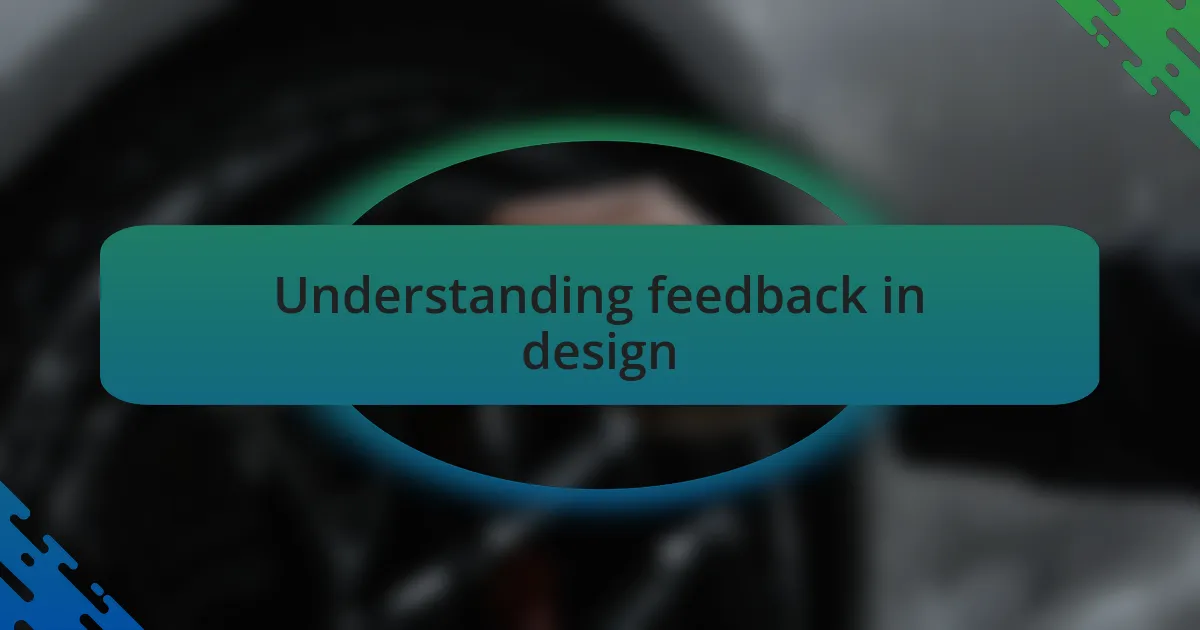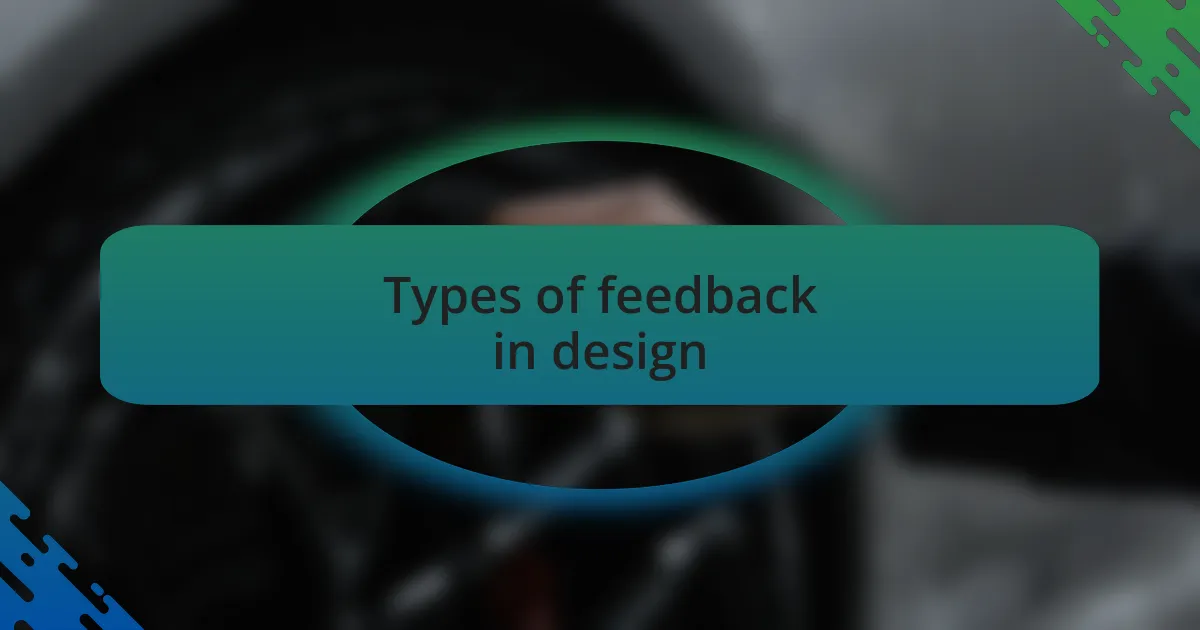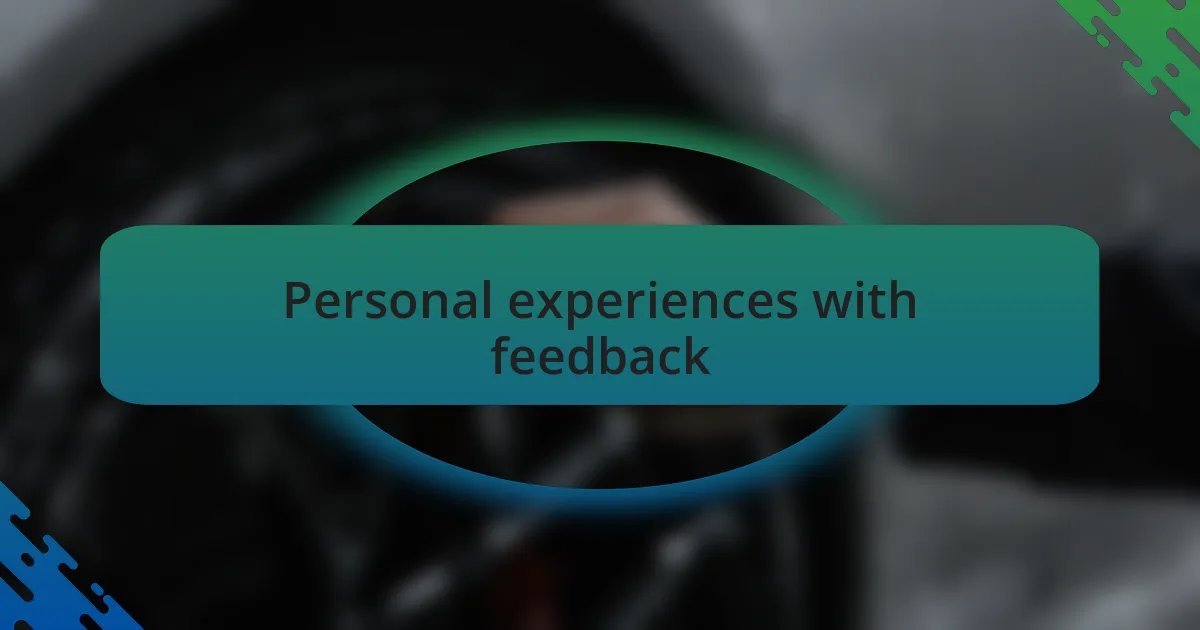Key takeaways:
- Feedback is essential for growth in design, transforming criticism into a collaborative tool that enhances creativity.
- Different types of feedback—direct, user, and peer—each play a critical role in shaping effective design outcomes.
- Maintaining an open mindset while receiving feedback fosters actionable insights and deeper understanding.
- Establishing structured processes for revisiting feedback and documenting responses can lead to continuous improvement and innovation.

Understanding feedback in design
Feedback in design is often seen as a mere formality, but I believe it’s a vital part of the creative process. I remember a project where my initial concept was met with mixed reviews; rather than feeling defeated, I delved deeper into understanding my team’s reactions. I began to view feedback as a tool for growth, rather than criticism, which fundamentally shifted my design approach.
At times, feedback can feel overwhelming, especially when it doesn’t align with your own vision. I’ve had moments where I clung to my designs, only to realize later that embracing alternative perspectives enriched the final product. This highlights the importance of being open-minded; the best designs emerge from collaboration, not isolation.
Isn’t it fascinating how feedback can transform an ordinary design into something extraordinary? Engaging with my peers and users has taught me that their insights often illuminate aspects I might overlook. This collaborative spirit not only enhances creativity but also fosters a sense of community that drives everyone towards a common goal.

Types of feedback in design
Feedback in design typically falls into several categories, each playing a distinct role in shaping a project. For instance, direct feedback comes from clients or stakeholders who provide specific inputs on a design deliverable. I recall presenting a wireframe to a client once and receiving detailed feedback about color choices and layout preferences. That experience taught me how critical this direct feedback can be in aligning the design with client expectations.
Another type can be user feedback, which emerges from those who actually interact with the product. I remember launching an app and watching users struggle with navigation. Their feedback was eye-opening; it reminded me that understanding the end-user experience is crucial. It also sparked an entirely new design iteration that made the interface far more intuitive.
Then there’s peer feedback, which typically involves critiques from fellow designers or industry colleagues. Participating in design reviews has often exposed me to fresh perspectives I hadn’t considered. I’ve learned that sometimes, a simple question from a peer can unveil a blind spot in my thinking, illustrating the potential for design improvement when we open ourselves to outside insights. Have you ever found that a colleague’s observation led you to a breakthrough? I know I have, and it reinforces how essential collaboration is in our field.

How to receive feedback effectively
Receiving feedback effectively is all about creating an open mindset. I remember a project where I received critical input from a user during a testing session. Instead of feeling defensive, I focused on understanding their perspective and asking follow-up questions. This approach not only deepened my understanding but also made the feedback more actionable. Isn’t it fascinating how a conversation can turn criticism into a roadmap for improvement?
It’s also important to filter and prioritize feedback. Not every piece of input will resonate, and that’s okay. I once faced a series of conflicting opinions from team members about a design element. It was challenging, but by evaluating the feedback through the lens of my design goals, I managed to identify the most relevant insights. Have you ever experienced that overwhelming feeling of too many opinions? Learning to sift through them has been a crucial skill in my development as a designer.
Finally, expressing gratitude for feedback can significantly enhance relationships with those providing it. I’ve learned that a simple “thank you” can encourage more openness and engagement in future discussions. After a particularly intense review session, I made it a point to acknowledge the input I received and show appreciation for my colleagues’ time and effort. Creating a positive atmosphere fosters ongoing dialogue and innovation—don’t you think that’s what collaboration is all about?

Strategies for incorporating feedback
One effective strategy for incorporating feedback is to establish a structured process for revisiting it over time. I once developed a design project that was heavily influenced by initial user feedback, but I soon realized that many insights required deeper exploration. By scheduling regular review sessions throughout the project’s lifecycle, I ensured that feedback wasn’t just a one-time event; it became a continuous conversation. Have you ever noticed how revisiting input can spark new ideas?
Another important tactic is to prototype concepts based on feedback and test them iteratively. I remember when I changed a user flow in response to a suggestion from a focus group—it was a bit of a gamble! However, creating a low-fidelity prototype allowed me to gather further insights quickly. This iterative approach not only validated the changes but also made the stakeholders feel like co-creators. Isn’t it fascinating how quickly a concept can evolve when you actively involve others in the process?
Lastly, documenting feedback and your responses can provide invaluable clarity and track your design evolution. I’ve often jotted down feedback points in a shared document, followed by notes on how I addressed them. Reflecting on the changes made can reveal patterns and growth in your design practice. Have you ever thought about how documentation can help solidify lessons learned, creating a more informed foundation for future projects?

Personal experiences with feedback
When I first started receiving feedback on my designs, I approached it with a mix of excitement and trepidation. I remember a particular instance where my layout wasn’t resonating with my peers, and it stung a bit. The feedback felt like a personal critique, but looking back, it urged me to rethink my design choices and explore more user-centered solutions. How often do we let initial reactions cloud our understanding of constructive criticism?
There was a time during a project when I felt quite attached to a specific color palette I had chosen. A colleague pointed out that it might not be appealing to our target demographic, and my initial response was defensive. However, as I calmed down and reflected, I realized they were advocating for the users, not against my abilities. It was a turning point for me; I learned to separate my ego from my work. Don’t you find it empowering when we can shift our perspective in light of feedback?
Another memorable experience was during a brainstorming session where we collectively reviewed design mockups. The atmosphere was charged with energy as every piece of input felt like a building block for something bigger. One suggestion led to a major pivot in our design direction, and I could see the team’s enthusiasm grow as we solidified our ideas. This collaborative environment emphasized how sharing feedback can ignite creativity. Have you experienced moments where collective insights transformed your approach?